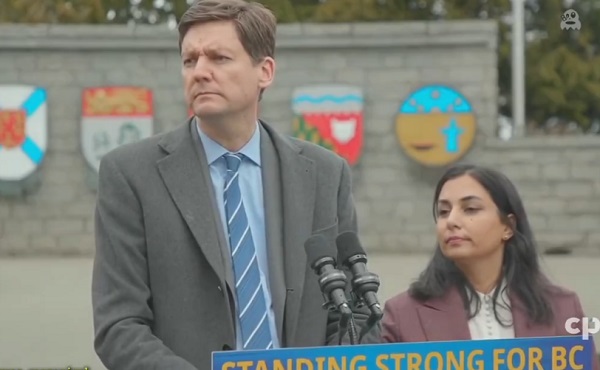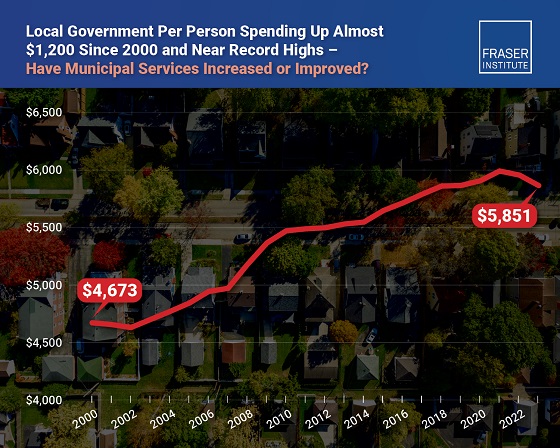Fraser Institute
Opposition says Premier Eby using tariff fight to give B.C. cabinet ‘unlimited power’

From the Fraser Institute
By Bruce Pardy
It’s been 800 years since the Magna Carta. Governments everywhere now aspire to tear down the concept that it helped establish: the rule of law. Last week, British Columbia’s NDP government introduced the Economic Stabilization (Tariff Response) Act, also known as Bill 7, which would allow Premier David Eby and his cabinet the power to take the law into their own hands without going through the elected legislature.
In this case, the justification is President Donald Trump’s tariffs. But the bill would authorize any action taken for the vague purpose of supporting the economy of B.C. or Canada, or responding to the actions of any foreign government, even if the actions haven’t happened yet. But according to Eby, “These are not sweeping powers.”
The project of concentrating power in the executive branch (i.e. cabinet) and usurping the role of legislators has a long pedigree. In theory, no office or officers are above the law or are empowered to make it up as they go. In practise, that theory counts for less and less. Governments, including in Canada, don’t like the rule of law.
But what, exactly, does “the rule of law” mean? Legal theorists say it’s complicated. It need not be. To see it clearly, compare it to the alternative: the rule of persons. When King Solomon decreed that a baby claimed by two women should be split in half, he had absolute power to decide what to do. When Henry VIII ordered that Anne Boleyn should lose her head, that was absolute power, too. In each case, tyrants exercised their personal rule for good or bad.
The “rule of law” is the opposite idea. No single authority has free reign to decide how the state will use its force. The rule of law limits the powers of those who govern.
It does so in part by separating powers between three branches of the state. The Supreme Court of Canada has said that the “separation of powers” is a fundamental feature of the Canadian Constitution. Legislatures legislate. The executive executes. Judges adjudicate. In principle, no single office or officer can alone decide what should be done.
But not in practise. Exceptions are so common today as to be ubiquitous. The Human Rights Commission, not the legislature, declares what constitutes discrimination. The police decide whether to enforce court orders. Environment ministry officials determine when environmental impacts are permissible. Cabinet decides when pipelines will be built.
But in these cases, decision-makers at least must keep themselves within the boundaries of their authorizing statute, which was passed by elected legislatures. Under Bill 7, the Eby government will take delegation to the next level. Its cabinet will have the power not just to exercise broad discretion in accordance with legislation, but to override legislation itself. The bill will allow cabinet to make exceptions to the law, modify the law’s requirements, limit the law’s application, or establish powers or duties in place of the law. And not just a specific law, but any enactment on the books. The cabinet’s edicts will be valid for more than two years, until May 2027.
In 1539, the Statute of Proclamations conferred on King Henry VIII the power to rule by decree, directing that the King’s proclamations should be obeyed as though they were legislation. Such provisions, since known as “Henry VIII clauses,” are controversial because they eviscerate limits on executive power. Yet they may be constitutionally permissible in Canada. Parliament cannot abdicate its functions, the Supreme Court of Canada wrote in 1918, in a case considering the government’s conscription orders under the broad powers of the War Measures Act of 1914. But Parliament can pass legislation that delegates its powers to the executive as it sees fit. As long as the legislature retains the power to reverse the delegation, the theory goes, then separation of powers remains intact.
The rule of law is inconvenient. It gets in the way of governments and officials crafting solutions to problems they perceive as important. That’s not its downside but its purpose. Even when government efforts are well-intentioned, the power of officials to solve problems can pose a more serious threat to citizens than the problem itself. As the late Alan Borovoy, former general counsel of the Canadian Civil Liberties Association, once put it, “The source of the most insidious peril is not evil wrongdoers seeking to do harm, but parochial bureaucrats seeking to do good.” If the modern administrative state is incompatible with the rule of law, then the state should be required to adapt. For decades, the current has flowed strongly in the other direction.
Crises are an ideal time for the state to advance into territory from which it will not wish to retreat. COVID-19 was the previous excuse. Now the threat of American tariffs is the latest justification to declare an emergency and discard the limitations of the rule of law. Even impending calamity does not justify the tyranny of unfettered discretion. Boundless authority to respond to circumstances is an unbearable licence to dictate.
This commentary is based on previous commentaries.
Business
Massive government child-care plan wreaking havoc across Ontario

From the Fraser Institute
By Matthew Lau
It’s now more than four years since the federal Liberal government pledged $30 billion in spending over five years for $10-per-day national child care, and more than three years since Ontario’s Progressive Conservative government signed a $13.2 billion deal with the federal government to deliver this child-care plan.
Not surprisingly, with massive government funding came massive government control. While demand for child care has increased due to the government subsidies and lower out-of-pocket costs for parents, the plan significantly restricts how child-care centres operate (including what items participating centres may purchase), and crucially, caps the proportion of government funds available to private for-profit providers.
What have families and taxpayers got for this enormous government effort? Widespread child-care shortages across Ontario.
For example, according to the City of Ottawa, the number of children (aged 0 to 5 years) on child-care waitlists has ballooned by more than 300 per cent since 2019, there are significant disparities in affordable child-care access “with nearly half of neighbourhoods underserved, and limited access in suburban and rural areas,” and families face “significantly higher” costs for before-and-after-school care for school-age children.
In addition, Ottawa families find the system “complex and difficult to navigate” and “fewer child care options exist for children with special needs.” And while 42 per cent of surveyed parents need flexible child care (weekends, evenings, part-time care), only one per cent of child-care centres offer these flexible options. These are clearly not encouraging statistics, and show that a government-knows-best approach does not properly anticipate the diverse needs of diverse families.
Moreover, according to the Peel Region’s 2025 pre-budget submission to the federal government (essentially, a list of asks and recommendations), it “has maximized its for-profit allocation, leaving 1,460 for-profit spaces on a waitlist.” In other words, families can’t access $10-per-day child care—the central promise of the plan—because the government has capped the number of for-profit centres.
Similarly, according to Halton Region’s pre-budget submission to the provincial government, “no additional families can be supported with affordable child care” because, under current provincial rules, government funding can only be used to reduce child-care fees for families already in the program.
And according to a March 2025 Oxford County report, the municipality is experiencing a shortage of child-care staff and access challenges for low-income families and children with special needs. The report includes a grim bureaucratic predication that “provincial expansion targets do not reflect anticipated child care demand.”
Child-care access is also a problem provincewide. In Stratford, which has a population of roughly 33,000, the municipal government reports that more than 1,000 children are on a child-care waitlist. Similarly in Port Colborne (population 20,000), the city’s chief administrative officer told city council in April 2025 there were almost 500 children on daycare waitlists at the beginning of the school term. As of the end of last year, Guelph and Wellington County reportedly had a total of 2,569 full-day child-care spaces for children up to age four, versus a waitlist of 4,559 children—in other words, nearly two times as many children on a waitlist compared to the number of child-care spaces.
More examples. In Prince Edward County, population around 26,000, there are more than 400 children waitlisted for licensed daycare. In Kawartha Lakes and Haliburton County, the child-care waitlist is about 1,500 children long and the average wait time is four years. And in St. Mary’s, there are more than 600 children waitlisted for child care, but in recent years town staff have only been able to move 25 to 30 children off the wait list annually.
The numbers speak for themselves. Massive government spending and control over child care has created havoc for Ontario families and made child-care access worse. This cannot be a surprise. Quebec’s child-care system has been largely government controlled for decades, with poor results. Why would Ontario be any different? And how long will Premier Ford allow this debacle to continue before he asks the new prime minister to rethink the child-care policy of his predecessor?
Business
Municipal government per-person spending in Canada hit near record levels

From the Fraser Institute
Municipal government spending in Canada hit near record levels in recent years, finds a new study by the Fraser Institute, an independent, non-partisan Canadian public policy think-tank.
“In light of record-high spending in municipalities across Canada, residents should consider whether or not crime, homelessness, public transit and other services have actually improved,” said Austin Thompson, senior policy analyst at the Fraser Institute and author of The Expanding Finances of Local Governments in Canada.
From 2000 to 2023, per-person spending (inflation-adjusted) increased by 25.2 per cent, reaching a record-high $5,974 per person in 2021 before declining slightly to $5,851 in 2023, the latest year of available data.
During that same period, municipal government revenue—generated from property taxes and transfers from other levels of government—increased by 33.7 per cent per person (inflation-adjusted).
And yet, among all three levels of government including federal and provincial, municipal government spending (adjusted for inflation) has actually experienced the slowest rate of growth over the last 10 years, underscoring the large spikes in spending at all government levels across Canada.
“Despite claims from municipal policymakers about their dire financial positions, Canadians should understand the true state of finances at city hall so they can decide whether they’re getting good value for their money,” said Jake Fuss, director of fiscal studies at the Fraser Institute.
The Expanding Finances of Local Governments in Canada, 1990–2023
- Canada’s local governments have experienced substantial fiscal growth in recent decades.
- Revenue and expenditure by local governments—including municipal governments, school boards, and Indigenous governments—have increased faster than population growth and inflation combined. From 1990 to 2023, real per-capita revenue rose by 32.7%, and expenditure by 30.0%.
- Local governments represent a significant component of Canada’s broader public sector. In 2023, net of inter-governmental transfers, municipal governments and school boards accounted for 18.6% of total government expenditure and 11.1% of revenue.
- Despite this growth, local governments’ share of overall government revenue and expenditure has declined over time—especially since the COVID-19 pandemic—as federal and provincial budgets have expanded even more rapidly.
- Nevertheless, between 2008 and 2023 the inflation-adjusted per-capita revenue of municipal governments in-creased by 10.1% and their expenditure by 12.4% , on average across the provinces.
- Over the same period, municipal governments recorded above-inflation increases in their combined annual operating surpluses, which contributed to an 88.1% inflation-adjusted rise in their net worth—raising important questions about the allocation of accumulated resources.
- In 2023, Ontario recorded the highest per-capita municipal revenue among the provinces ($4,156), while Alberta had the highest per-capita expenditure ($3,750). Prince Edward Island reported the lowest per-capita municipal revenue ($1,635) and expenditure ($1,186).
- Wide variation in per-capita municipal revenue and expenditure across the provinces reflects differences in the responsibilities provinces assign to municipalities, as well as possible disparities in the efficiency of service delivery—issues that warrant further scrutiny.
Click Here To Read The Full Study
-

 Brownstone Institute2 days ago
Brownstone Institute2 days agoFDA Exposed: Hundreds of Drugs Approved without Proof They Work
-

 Energy1 day ago
Energy1 day agoChina undermining American energy independence, report says
-

 Business1 day ago
Business1 day agoTrump on Canada tariff deadline: ‘We can do whatever we want’
-

 Automotive1 day ago
Automotive1 day agoElectric vehicle sales are falling hard in BC, and it is time to recognize reality.
-

 Business1 day ago
Business1 day agoEurope backs off greenwashing rules — Canada should take note
-

 Automotive1 day ago
Automotive1 day agoPower Struggle: Electric vehicles and reality
-

 Business3 hours ago
Business3 hours agoCanada Caves: Carney ditches digital services tax after criticism from Trump
-

 Crime3 hours ago
Crime3 hours agoSuspected ambush leaves two firefighters dead in Idaho









